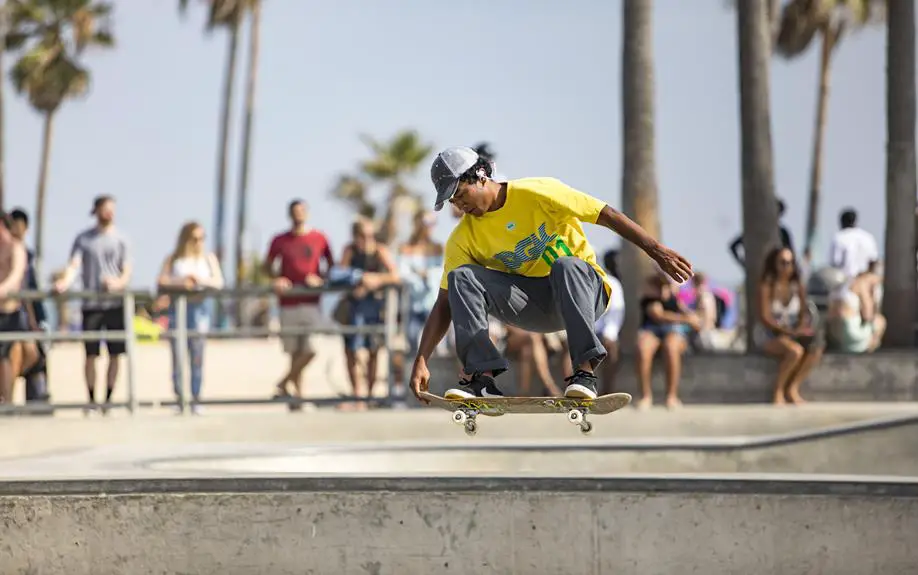Did you know that skateboarding is more than just a hobby? It’s a global phenomenon that has taken the world by storm, captivating the hearts of millions. But what if I told you that skateboarding isn’t just about performing tricks and riding on a board? It’s about breaking barriers, pushing limits, and embracing a unique lifestyle.
For those who have struggled with finding their place in the world or feeling like they don’t quite fit in, skateboarding offers a sense of belonging and freedom. It’s a way to express yourself, challenge yourself, and connect with a community that understands your passion.
In this article, I delve into the fascinating skateboarding statistics. This way, you’ll understand the sport better.
Market Size and Growth
The global skateboarding market is expected to grow, reaching $2.4 billion by 2025. This growth can be attributed to the increasing popularity of skateboarding worldwide. There are approximately 50 million skateboarders globally, with the number steadily increasing.
It’s interesting to note that most skateboarders, around 77%, prefer to shop at small skate shops rather than chain stores. This preference for local businesses highlights the sense of community and belonging that skateboarders desire.
In the United States alone, specialty skate shops account for 59.2% of board sales. This indicates the importance of these small businesses in the skateboarding industry.
The global skateboarding market isn’t only thriving and fostering a sense of belonging among skateboarders.
Global Skateboarding Market Projection
By 2024, you can expect the global skateboarding market to reach a value of $3 billion. Here are three key factors that contribute to this projection:
Growing popularity:
- Skateboarding continues to gain traction worldwide, with an estimated 50 million skateboarders globally.
- This increasing interest in the sport drives the demand for skateboarding products and contributes to the market’s growth.
Emerging markets:
- The Asia Pacific region is expected to be the fastest-growing region in the skateboard market.
- With a population of 11 million people regularly practicing skateboarding, this region presents significant opportunities for industry expansion and revenue generation.
Shift towards specialty shops:
- Skateboarders prefer shopping at small, specialty skate shops rather than chain stores.
- As a result, these independent retailers account for a significant portion of board sales, particularly in the United States.
- This trend emphasizes the importance of creating a sense of belonging and community within the skateboarding industry.
Number of Skateboarders Worldwide
With an estimated 50 million skateboarders worldwide, you can see this sport’s global reach and popularity. Skateboarding has captivated people from all walks of life, creating a sense of belonging and community among its enthusiasts.
Whether cruising through the streets or performing jaw-dropping tricks at skate parks, skateboarders have formed a tight-knit global network. To give you a deeper understanding of the skateboarding world, take a look at the table below:
| Continent | Number of Skateboarders |
|---|---|
| North America | 15 million |
| Europe | 12 million |
| Asia Pacific | 10 million |
| Latin America | 8 million |
| Africa | 5 million |
As you can see, skateboarding is not limited to a specific region or culture. It has found its place in every corner of the world, bringing people together through their shared love for the sport. Whether you’re a beginner or a seasoned pro, you can always find a community of skateboarders ready to welcome you with open arms.
Preference for Small Skate Shops
If you’re looking for a unique skateboarding shopping experience, you’ll find that most skateboarders prefer small skate shops over chain stores. Here’s why:
- Personalized Service: Small skate shops take pride in providing personalized assistance to skateboarders. The staff at these shops are often experienced skateboarders themselves, offering valuable advice and recommendations tailored to your specific needs.
- Unique Selection: Small skate shops often stock a curated selection of skateboarding gear and apparel you won’t find in chain stores. They support local and independent brands, giving you access to unique, limited-edition products that reflect the skateboarding culture.
- Community Atmosphere: Small skate shops foster a sense of community and belonging. They serve as meeting places for skateboarders to connect, share stories, and build relationships. These shops often host events, contests, and workshops, creating opportunities for skateboarders to come together and celebrate their passion.
Choosing to shop at small skate shops supports local businesses and allows you to be part of a vibrant skateboarding community that understands and shares your love for the sport.
Board Sales From Specialty Skate Shops
When shopping for a new skateboard, you’ll find that specialty skate shops account for most board sales in the US. These shops cater specifically to skateboarders and offer a wide range of boards to choose from.
They provide a unique and personalized shopping experience where you can receive expert advice and recommendations based on your skill level and preferences. Specialty skate shops also support the skateboarding community by organizing events, sponsoring local skaters, and creating a sense of belonging for skateboarders.
To emphasize the importance of specialty skate shops, take a look at the table below:
| Board Sales in the US | |
|---|---|
| Specialty Skate Shops | 59.2% |
| Chain Stores | 40.8% |
As you can see, specialty skate shops dominate the market, accounting for nearly 60% of board sales. This highlights the significance of these shops in the skateboarding industry and the trust skateboarders have in their expertise.
So, next time you’re in the market for a new skateboard, consider supporting your local specialty skate shop and join the vibrant skateboarding community.
Number of Skate Parks in the United States
You’ll be interested to know that the United States has approximately 3,500 skate parks.
Here are three key insights about the number of skate parks in the country:
- Community Engagement: Skate parks foster a sense of belonging within the skateboarding community. They provide a safe and inclusive space for skateboarders of all ages and skill levels to connect and share their passion for the sport.
- Accessible Recreation: The presence of numerous skate parks across the United States ensures that skateboarding is accessible to a wider audience. These parks offer opportunities for individuals to engage in physical activity, develop their skills, and cultivate a sense of personal achievement.
- Local Economies: Skate parks also have a positive impact on local economies. They attract visitors, host competitions and events, and contribute to the growth of adjacent businesses such as skate shops, cafes, and apparel stores, creating a thriving ecosystem that benefits both the skateboarding community and the local community at large.
Fastest-Growing Region in the Skateboard Market
The Asia Pacific region is experiencing rapid growth in the skateboard market. With a thriving skateboarding culture and a growing number of enthusiasts, this region has become the fastest-growing in the industry.
Skateboarding has gained immense popularity among the youth in countries like China, Japan, and South Korea, where skate parks and skateboarding events are flourishing. The Asia Pacific region offers a unique blend of traditional skateboarding styles and emerging trends, making it an exciting hub for skateboarders.
As the skateboarding community continues to expand in this region, it fosters a sense of belonging and camaraderie among skateboarders. The growth of the skateboard market in the Asia Pacific region reflects the increasing demand for skateboarding products and signifies the cultural significance and impact of skateboarding in this part of the world.
Skateboarding Demographics
To better understand the skateboarding community, let’s explore the demographics and characteristics of skateboarders.
- Age: The average skateboarder is between 12 and 17 years old, reflecting the youthful energy and passion that drives the sport. Skateboarding provides a sense of freedom and self-expression, making it particularly appealing to teenagers seeking excitement and individuality.
- Gender: While skateboarding has historically been male-dominated, there’s a growing number of female skateboarders. Currently, 21% of skateboarders are female, highlighting the increasing inclusivity and diversity within the skateboarding community. Efforts should be made to bridge the gender gap and create a more welcoming and equal environment for all skateboarders.
- Discipline: Street skateboarding is the most popular discipline, with 63% of participants engaging in urban riding. Skateboarders thrive on the challenges and creativity that street skating offers as they navigate the urban landscape with style and skill.
Understanding the demographics of skateboarders allows us to appreciate the diverse and vibrant community that exists within the sport. As skateboarding continues to evolve, inclusivity and diversity will be key factors in shaping its future.
Average Age of Skateboarders
Skateboarders are typically in their early teens, as the average age ranges from 12 to 17 years old. This age group is drawn to the thrill and freedom that skateboarding offers. It’s a time when individuals seek adventure and push boundaries, and skateboarding perfectly aligns with those desires.
Being part of this community allows you to belong to a group of like-minded individuals who share a passion for the sport. Skateboarding not only provides physical exercise and skill development, but it also offers a sense of camaraderie and belonging.
Whether you’re just starting out or have been skating for years, there’s always room to grow and improve, and the skateboarding community is there to support and encourage you every step of the way.
Male-Female Ratio in Skateboarding
Joining the skateboarding community can help you understand the male-female ratio in skateboarding. Here are three things to consider:
1) Gender disparity: 79% of skateboarders are male, while only 21% are female. This gender gap is a significant issue in the skateboarding industry, and efforts should be made to create a more inclusive and diverse environment. Addressing the gender disparity can lead to industry growth and success.
2) Inclusive environment: Companies and skateboarding communities should take steps to cater to the needs of female skateboarders. By providing equal opportunities, resources, and support, we can encourage more women to participate and feel a sense of belonging within the skateboarding community.
3) Breaking stereotypes: Challenging the stereotypes and assumptions surrounding skateboarding as a male-dominated activity is important. By showcasing the achievements and stories of female skateboarders, we can inspire others and break down barriers, creating a more balanced male-female ratio in skateboarding.
Number of Skaters in the U.S
In 2019, there were approximately 6.7 million skaters in the U.S. This number represents a significant portion of the skateboarding community and showcases the sport’s popularity in the country. To further understand the demographics of these skaters, let’s take a look at the following table:
| Age Range | Male Skaters | Female Skaters |
|---|---|---|
| 12-17 | 2,500,000 | 670,000 |
| 18-24 | 1,800,000 | 400,000 |
| 25-34 | 1,200,000 | 300,000 |
| 35-44 | 900,000 | 200,000 |
| 45+ | 300,000 | 100,000 |
As we can see, most skaters fall within the 12-17 age range, with males comprising the largest portion of the skateboarding community. However, it is important to note that skateboarding is a sport that can be enjoyed by people of all ages and genders.
The diverse range of skaters contributes to the vibrant and inclusive skateboarding culture in the U.S. So, whether you’re a teenager looking to join the skateboarding community or an adult rediscovering your passion for the sport, there’s a place for you in the ever-growing skateboarding scene.
Popular Skateboarding Discipline
With street skateboarding remaining the most popular discipline, you’ll discover the thrill of navigating urban landscapes and mastering tricks. It’s a discipline that allows you to express your creativity and style, as you find unique spots to shred and push the boundaries of what’s possible on a skateboard.
Here are three reasons why street skateboarding continues to captivate skateboarders worldwide:
- Urban Exploration: Street skateboarding takes you to the heart of the city, where you can explore alleyways, plazas, and abandoned buildings. Every corner becomes a potential skate spot, offering endless possibilities for tricks and lines.
- Technical Mastery: Street skateboarding demands a high level of technical skill. From mastering flip tricks to grinding ledges and rails, you’ll constantly challenge yourself to push the limits and perfect your technique.
- Creative Expression: Street skateboarding isn’t just about executing tricks and creating your own unique style. You’ll develop your own flow and approach to obstacles, adding your personal touch to every maneuver.
In the world of skateboarding, street discipline holds a special place, providing a sense of belonging and camaraderie for those who embrace its urban playground.
Skateboarding Industry Revenue
To maximize your understanding of the skateboarding industry revenue, you can explore the market trends and preferences to gain insight into its financial growth.
Skateboarding isn’t just a hobby but a thriving industry that generates significant revenue. The skateboard shoe market alone is projected to be worth $2.48 billion by 2027. Element Skateboards, known for their high-quality products, was the top-selling brand in 2020.
Additionally, the hardware market, which includes skateboard decks, trucks, and wheels, was valued at $807 million USD in 2020. With its abundance of skateboarding culture, California is home to nearly half of all retail outlets in the United States.
Moreover, with its 11 million regular skateboarders, the Asia Pacific region is projected to be the fastest-growing region in the skateboard market. Understanding these revenue trends can help you navigate and find your place within the industry.
Projected Worth of Skateboard Shoe Market
Don’t miss out on the projected worth of the skateboard shoe market, which is estimated to reach $2.48 billion by 2027. This thriving market isn’t only lucrative and holds immense potential for growth and success.
Here are three key insights into the projected worth of the skateboard shoe market:
- Increasing demand: With the rising popularity of skateboarding worldwide, the demand for skateboard shoes is expected to soar. Skateboarders are always looking for durable, comfortable, and stylish footwear that can withstand the rigors of their sport.
- Innovation and technology: Skateboard shoe brands continuously invest in research and development to introduce innovative features and technologies. From enhanced grip and board feel to impact protection, these advancements drive consumer interest and create market expansion opportunities.
- Influencer marketing: Skateboarding influencers play a significant role in shaping consumer preferences and driving sales. Brands are leveraging the power of social media platforms to collaborate with popular skateboarders and promote their footwear, creating a strong sense of community and belonging among skateboard enthusiasts.
As the skateboard shoe market continues to grow, it presents a promising avenue for businesses to tap into and cater to the needs and desires of skateboarders worldwide.
Top-Selling Brand in 2020
Did you know that Element Skateboards was the top-selling brand in 2020?
As a skateboarder, you want to feel a sense of belonging and be part of a community that shares your passion. Element Skateboards understands this desire and has built a brand that resonates with skateboarders worldwide.
With their innovative designs, high-quality materials, and commitment to sustainability, Element has captured the hearts of skateboarders everywhere. Their products perform well and reflect the values and identity of the skateboarding culture.
From their iconic logo to their team of talented riders, Element has created a brand that speaks to the skateboarding community and fosters a sense of belonging.
Value of the Hardware Market
As a skateboarder, you may often wonder how frequently the hardware market is valued in the skateboarding industry. Well, here are three key insights for you:
- The hardware market was valued at $807 million USD in 2020, indicating its significant contribution to the overall skateboarding industry revenue.
- With its numerous retail outlets, California is considered the hub for the hardware market, accounting for nearly half of all retail outlets in the United States.
- The Asia Pacific region, with its 11 million people practicing skateboarding regularly, is a growing market for hardware products, presenting immense opportunities for growth and expansion.
Understanding the hardware market’s value is crucial for skateboarders like you as it reflects the industry’s financial growth and success and impacts the availability and accessibility of quality skateboarding equipment.
Concentration of Retail Outlets in California
With California being the hub for the hardware market, it attracts skateboarders like you with its concentration of retail outlets and ample opportunities for finding quality skateboarding equipment.
In fact, California is home to nearly half of all retail outlets in the United States, making it a paradise for skateboard enthusiasts. Whether you’re looking for a new deck, trucks, or bearings, you’ll find a wide selection of options to choose from.
Not only does California offer a diverse range of skate shops, but it also fosters a sense of belonging within the skateboarding community. You’ll find like-minded individuals who share your passion for the sport and can provide valuable advice and recommendations.
So, gear up and head to the Golden State to experience the ultimate skateboard shopping experience.
| Retail Outlet Name | Location |
|---|---|
| Skate Warehouse | San Diego |
| Active Ride Shop | Orange |
| Val Surf | Los Angeles |
Regular Skateboarding Practitioners in Asia Pacific
You’ll be interested to know that a growing number of skateboarders are regularly practicing in the Asia Pacific region. This region, known for its vibrant cultures and dynamic cities, has become a hub for skateboarding enthusiasts.
Here are three key insights about regular skateboarding practitioners in Asia Pacific:
- Increasing popularity: Skateboarding has gained immense popularity in Asia Pacific, with a staggering 11 million people regularly practicing this sport. This surge in interest can be attributed to the region’s vibrant skateboarding community and the increasing accessibility of skateboarding facilities.
- Emerging talent: Asia Pacific is witnessing the emergence of a new generation of talented skateboarders. With their unique styles and innovative tricks, these skaters make waves in global skateboarding. The region’s rich cultural heritage and diverse landscapes provide a fertile ground for creativity and inspiration.
- Thriving skateboarding culture: Skateboarding has become more than just a sport in Asia Pacific. It has evolved into a vibrant subculture, attracting individuals who seek a sense of belonging and expression. Skate parks and skateboarding events have become meeting grounds for like-minded individuals, fostering a strong sense of community and camaraderie.
As skateboarding continues to grow in popularity in the Asia Pacific region, it’s exciting to witness its positive impact on individuals, communities, and the overall skateboarding industry.
Gender Disparity in Skateboarding
There’s hope for reducing the gender disparity in skateboarding. While it’s true that currently, 79% of skateboarders are male, efforts are being made to create a more inclusive and diverse environment.
Addressing the gender disparity isn’t only important for promoting equality, but it can also positively impact the growth and success of the industry. Companies should take steps to cater to female skateboarders’ needs, whether by designing products specifically for them or creating welcoming and supportive spaces.
Creating an Inclusive Environment
Establishing a supportive and welcoming skateboarding community is essential to promote diversity and inclusivity. Here are three key actions that can help create an inclusive environment:
- Embrace diversity: Encourage individuals from different backgrounds, races, genders, and abilities to participate in skateboarding. Celebrate the unique perspectives and experiences they bring to the community.
- Provide accessibility: Make skate parks and facilities accessible to everyone, including individuals with disabilities. Ensure that ramps, rails, and other equipment are designed inclusively, allowing everyone to fully engage in the sport.
- Foster inclusivity through education: Promote education and awareness on issues such as gender equality, LGBTQ+ rights, and racial justice within the skateboarding community. Encourage open dialogue and create safe spaces for individuals to share their stories and experiences.
Conclusion
Get ready to shred into the exciting world of skateboarding statistics in 2024! With a projected market size of $2.4 billion and an estimated 50 million skateboarders worldwide, the skateboarding industry is reaching new heights.
However, there’s still work to create a more inclusive and diverse environment for all skateboarders. So grab your board, embrace the thrill, and join the movement towards a more inclusive skateboarding community.
The wheels of change are in motion, and the future looks rad!
Can Skateboarding Be a Career? Is it Possible to Make a Living on Your Board?





